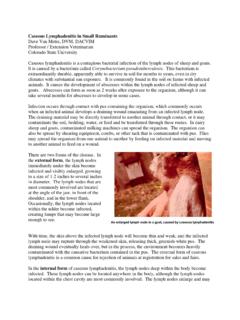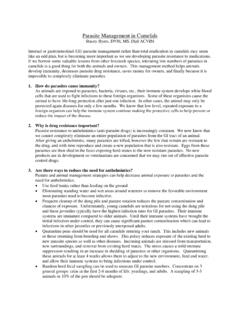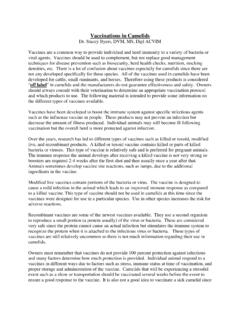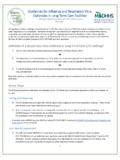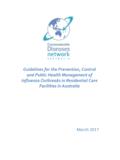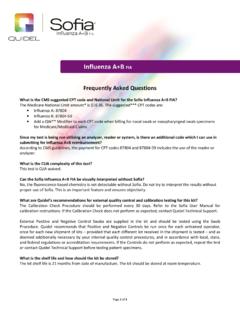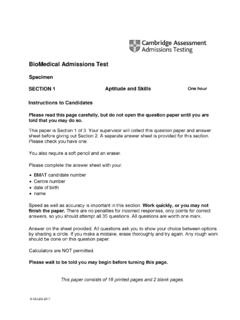Transcription of Atrophic Rhinitis Swine Influenza Mycoplasma Pneumonia
1 Mycoplasma PneumoniaPasterellosisPasterellosis typically occurs secondary toMycoplasma Pneumonia . It produces Pneumonia andsometimes inflammation of the heart and surroundingareas. Early and vigorous treatments with antibioticscan aid in air quality to help change the clinical signsof AR. Antibiotics can reduce AR in infected pigs,and will eliminate the organism from the nasalpassages, but treated pigs cannot be considered cured. PreventionImprovement of air quality, ventilation, sanitation,and reducing crowded conditions. Give pregnantsows 2 doses of a killed bacterin, 2 weeks apart, inthe late weeks of pregnacy to increase the antibodiesin the colostrum and milk. Antibiotic therapyadministered to the sows while the piglets arenursing may help to limit bacteria from the sow tothe babies. Segregated early weaning andmedicated early weaning may also limit the transferof AR agents from the sow to the piglets. EliminateAR from the herd by culling then repopulation withpigs from herds that have been shown to have noexisting Signs Watery eyes; leading to dark streaks of tears downthe sides of the face Sneezing Runny nose, occasionally a bloody nose, deviationor bulging of the snout over time Poor feed conversion with reduced daily gainAtrophic RhinitisAtrophic Rhinitis (AR) is a common respiratoryinfection of piglets that is caused by two bacteria,Bordatella brontiseptica and Pasteurella pigs exposed to adult pigs develop partialimmunity.
2 Adult sows then transmit AR to theirpiglets. Piglets may develop disease at any timefrom weaning until specific treatment exists for supportive therapy by maintainingventilation, clean feed and water. Because itis a viral disease, antibiotics (which treatbacterial infections) do not help. Yourveterinarian may prescribe antibiotics to preventsecondary bacterial infections that can veterinarian can confirm the diagnosisthrough blood tests or by testing for the virusin the nasal Signs Fever Quiet and reluctant to move A loud, dry, coug that sounds like barking Tearing, nasal discharge, and sneezing mayalso be pigs will become ill but typically only asmall % will die. Occasionally, certain strainsof the Influenza virus can move from pigs toinfect people, and Isolate new or show pigs for at least 3 may reduce infection risk, but itwill not always protect every pig. Swine InfluenzaAn outbreak of this virus can occur within daysafter introduction of new pigs onto the farm, orafter return of pigs from a show.
3 This especiallyoccurs among confined pigs, particularly in thewinter when ventilation may be reduced tomaintain thousing can be cultured from the nasal passagesto make a diagnosis. Your veterinarian also caninspect the lungs of pigs at slaughter and make Signs Intermittent coughing that persists for days toweeks and worsens with dust and odor problemswithin enclosed hog facilities. Pigs show a decreased rate of gain despite normalfeed intake and become less efficient at convertingfeed to is critical to understand that problems withmycoplasma Pneumonia signal that ventilation, airquality, stocking rate, stress, and immunizationpractices need to be pigs usually maintain a good appetite,antibiotics may be added to the hyopneumoniae is a bacteria thatcauses Pneumonia in pigs. The illness is usuallynot fatal, but lingers for weeks as a low-grade cough. Dr. Noa Rom n Mu iz Bilingual VeterinarianDr. Dave Van MetreCSU / ILM VeterinarianFort Collins, CO 80523970-221-4535 Respiratory Diseasesof SwineRespiratory diseases are common in pigshoused indoors.
4 Many infectious agents(bacteria and viruses) can be transmitted in theair that is shared by pigs that are housedtogether. Assessing your facility and creatinga program to control respiratory disease in yourheard can decrease economic Johnson-Nichols, CVTILM / Cooperative ExtensionClinical Signs Early signs are fever, poor appetite, and stiffness. These are followed by shallow respiration, coughing,and blood-tinged nasal discharge. Death may occurTreatmentTreat the entire herd with injectable antibiotics. Avariety of antibiotics can be used; check with yourveterinarian. APP pigs usually do not eat, antibioticsDiagnosisYour veterinarian can take samples from the lungs ofPreventionBecause a pig infected with APP may appear healthy,it is critical that any pigs purchased to be introducedto your herd are first tested for the disease. The testis a blood test that detects infection. All new pigsthat are bought should be kept isolated until blood testresults are final.
5 Purchase new pigs for your herdPleuropneumoniaActinobacillus pleuropneumoniae (APP) is a bacteriathat causes a very deadly form of Pneumonia only inpigs. Purchasing APP pigs that appear healthyand exposing them to your herd can quicky sprea

